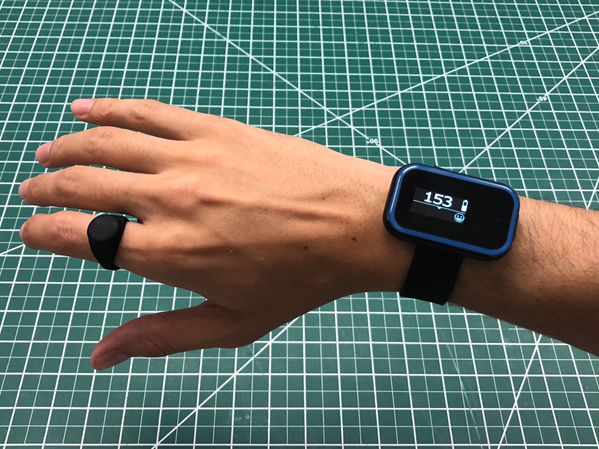Body
Wearable technologies such as wrist-worn sensors and phone apps for counting steps are increasingly used in our everyday life and have proven useful for promoting health and function of people without disabilities. Unfortunately, these products are not tailored to people with movement impairments and may be inaccurate for these persons, highlighting the need for customized devices for specific patient populations.
Recently, Flint Rehabilitation Devices developed a wearable sensing platform that consists of a small printed circuit board with a 3-axis accelerometer and gyroscope, and is unique in having an array of 3-axis magnetometers.
This platform was designed to work with the Manumeter, an interactive wearable device for monitoring daily use of the wrist and fingers, designed at the University of California, Irvine. The Manumeter is unique in its ability to detect finger and wrist movement while looking like jewelry: the user wears a small permanent magnet as a ring, and a sensing/logging wristband detects changes in the magnetic field as the ring moves. A screen displays how many finger movements users make each day. Ongoing research is testing whether the Manumeter can help people with a chronic stroke increase their amount of hand use at home.

Using this hardware, our goal is to develop and test a new set of algorithms that provides accurate feedback not just about hand movement, but also gait, arm, and custom limb movement, for both people with stroke and spinal cord injury (and, eventually, people with other causes of disability).
Within the current funding cycle (2018-2023), we will:
- Develop a non-obtrusive wearable sensor called E-DID (Enough – Did I Do) that can collaborate with the patient and therapist to accurately measure important target movements (including steps, arm and hand activity, and specific limb movements) and provide feedback throughout the day about progress
- Build the E-DID using a wearable sensing platform, in collaboration with our industrial partner, Flint Rehabilitation Devices
- Pilot test the E-DID at the University of California, Irvine with persons recovering from stroke in the out-patient setting, and evaluate it in a study on uptake at the Shirley Ryan AbilityLab.
We hypothesize that patients and their therapists who use the E-DID to set and monitor realistic, person-specific movement goals will achieve those goals.
Team Members
Body
David Reinkensmeyer, PhD, University of California, Irvine
Arun Jayaraman, PT, PhD, Shirley Ryan AbilityLab and Northwestern University
Heike Vallery, Dr.-Ing, TU Delft
Body
The contents of this webpage were developed under a grant from the National Institute on Disability, Independent Living, and Rehabilitation Research (NIDILRR grant number 90REGE0005-01-00). NIDILRR is a Center within the Administration for Community Living (ACL), Department of Health and Human Services (HHS). The contents of this webpage do not necessarily represent the policy of NIDILRR, ACL, or HHS, and you should not assume endorsement by the Federal Government.
This project is part of the Collaborative Machines Enhancing Therapies (COMET) Rehabilitation Engineering Research Center.